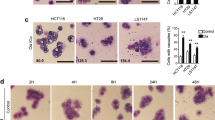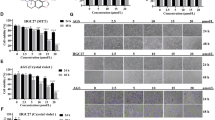Abstract
Nonsteroidal anti-inflammatory drugs (NSAIDs) induce apoptosis in cancer cells and this effect is involved in their antitumor activity. We recently demonstrated that NSAIDs upregulate GRP78, an endoplasmic reticulum (ER) chaperone, in gastric mucosal cells in primary culture. In the present study, induction of ER chaperones by NSAIDs and the effect of those chaperones on NSAID-induced apoptosis were examined in human gastric carcinoma cells. Celecoxib, an NSAID, upregulated ER chaperones (GRP78 and its cochaperones ERdj3 and ERdj4) but also C/EBP homologous transcription factor (CHOP), a transcription factor involved in apoptosis. Celecoxib also upregulated GRP78 in xenograft tumors, accompanying with the suppression of tumor growth in nude mice. Celecoxib caused phosphorylation of eukaryotic translation initiation factor 2 kinase (PERK) and eukaryotic initiation factor-2α (eIF2α) and production of activating transcription factor (ATF)4 mRNA. Suppression of ATF4 expression by small interfering RNA (siRNA) partially inhibited the celecoxib-dependent upregulation of GRP78. Celecoxib increased the intracellular Ca2+ concentration, while 1,2-bis(2-aminophenoxy)ethane-N,N,N′N′-tetraacetic acid, an intracellular Ca2+ chelator, inhibited the upregulation of GRP78 and ATF4. These results suggest that the Ca2+-dependent activation of the PERK-eIF2α-ATF4 pathway is involved in the upregulation of ER chaperones by celecoxib. Overexpression of GRP78 partially suppressed the apoptosis and induction of CHOP in the presence of celecoxib and this suppression was stimulated by coexpression of either ERdj3 or ERdj4. On the other hand, suppression of GRP78 expression by siRNA drastically stimulated cellular apoptosis and production of CHOP in the presence of celecoxib. These results show that upregulation of ER chaperones by celecoxib protects cancer cells from celecoxib-induced apoptosis, thus may decrease the potential antitumor activity of celecoxib.
This is a preview of subscription content, access via your institution
Access options
Subscribe to this journal
Receive 50 print issues and online access
$259.00 per year
only $5.18 per issue
Buy this article
- Purchase on Springer Link
- Instant access to full article PDF
Prices may be subject to local taxes which are calculated during checkout










Similar content being viewed by others
Abbreviations
- ATF:
-
activating transcription factor
- BAPTA-AM:
-
1,2-bis(2-aminophenoxy)ethane-N,N,N′N′-tetraacetic acid
- CHOP:
-
C/EBP homologous transcription factor
- COX:
-
cyclooxygenase
- eIF2α:
-
eukaryotic initiation factor-2α
- ER:
-
endoplasmic reticulum
- FACS:
-
fluorescence-activated cell sorting
- FBS:
-
fetal bovine serum
- IRE1:
-
protein-kinase and site-specific endoribonuclease
- NSAIDs:
-
non-steroidal anti-inflammatory drugs
- PERK:
-
eukaryotic translation initiation factor 2 kinase
- PG:
-
prostaglandin
- PI:
-
propidium iodide
- SERCA:
-
sarco endoplasmic reticulum Ca2+ ATPase
- siRNA:
-
small interfering RNA
- XBP-1:
-
X box binding protein
References
Alves da Costa C, Paitel E, Mattson MP, Amson R, Telerman A, Ancolio K et al. (2002). Proc Natl Acad Sci USA 99: 4043–4048.
Ben-Chetrit E, Fischel R, Hinz B, Levy M . (2005). Rheumatol Int 25: 332–335.
Bertolotti A, Zhang Y, Hendershot LM, Harding HP, Ron D . (2000). Nat Cell Biol 2: 326–332.
Bush KT, Goldberg AL, Nigam SK . (1997). J Biol Chem 272: 9086–9092.
Dong D, Ko B, Baumeister P, Swenson S, Costa F, Markland F et al. (2005). Cancer Res 65: 5785–5791.
Drummond IA, Lee AS, Resendez Jr E, Steinhardt RA . (1987). J Biol Chem 262: 12801–12805.
Eberhart CE, Coffey RJ, Radhika A, Giardiello FM, Ferrenbach S, DuBois RN . (1994). Gastroenterology 107: 1183–1188.
Elder DJ, Halton DE, Hague A, Paraskeva C . (1997). Clin Cancer Res 3: 1679–1683.
Fan XM, Wong BC, Lin MC, Cho CH, Wang WP, Kung HF et al. (2001). J Gastroenterol Hepatol 16: 1098–1104.
Farrow DC, Vaughan TL, Hansten PD, Stanford JL, Risch HA, Gammon MD et al. (1998). Cancer Epidemiol Biomarkers Prev 7: 97–102.
Fernandez PM, Tabbara SO, Jacobs LK, Manning FC, Tsangaris TN, Schwartz AM et al. (2000). Breast Cancer Res Treat 59: 15–26.
Gotoh T, Terada K, Mori M . (2001). Cell Death Differ 8: 357–366.
Gupta RA, Dubois RN . (2001). Nat Rev Cancer 1: 11–21.
Hanif R, Pittas A, Feng Y, Koutsos MI, Qiao L, Staiano-Coico L et al. (1996). Biochem Pharmacol 52: 237–245.
Harding HP, Novoa I, Zhang Y, Zeng H, Wek R, Schapira M et al. (2000). Mol Cell 6: 1099–1108.
Hong M, Li M, Mao C, Lee AS . (2004). J Cell Biochem 92: 723–732.
Hoshino T, Tsutsumi S, Tomisato W, Hwang HJ, Tsuchiya T, Mizushima T . (2003). J Biol Chem 278: 12752–12758.
Hu PJ, Yu J, Zeng ZR, Leung WK, Lin HL, Tang BD et al. (2004). Gut 53: 195–200.
Huang YC, Chuang LY, Hung WC . (2002). Mol Pharmacol 62: 1515–1521.
Huo R, Zhu YF, Ma X, Lin M, Zhou ZM, Sha JH . (2004). Cell Tissue Res 316: 359–367.
Husain SS, Szabo IL, Tamawski AS . (2002). Am J Gastroenterol 97: 542–553.
Jamora C, Dennert G, Lee AS . (1996). Proc Natl Acad Sci USA 93: 7690–7694.
Jiang HY, Wek SA, McGrath BC, Lu D, Hai T, Harding HP et al. (2004). Mol Cell Biol 24: 1365–1377.
Johnson AJ, Hsu AL, Lin HP, Song X, Chen CS . (2002). Biochem J 366: 831–837.
Kao JP, Harootunian AT, Tsien RY . (1989). J Biol Chem 264: 8179–8184.
Kaufman RJ . (2002). J Clin Invest 110: 1389–1398.
Kawai S, Nishida S, Kato M, Furumaya Y, Okamoto R, Koshino T et al. (1998). Eur J Pharmacol 347: 87–94.
Kismet K, Akay MT, Abbasoglu O, Ercan A . (2004). Cancer Detect Prev 28: 127–142.
Koki AT, Masferrer JL . (2002). Cancer Control 9: 28–35.
Koomagi R, Mattern J, Volm M . (1999). Anticancer Res 19: 4333–4336.
Kulp SK, Yang YT, Hung CC, Chen KF, Lai JP, Tseng PH et al. (2004). Cancer Res 64: 1444–1451.
Kurisu J, Honma A, Miyajima H, Kondo S, Okumura M, Imaizumi K . (2003). Genes Cells 8: 189–202.
Landry SJ . (2003). Biochemistry 42: 4926–4936.
Leahy KM, Ornberg RL, Wang Y, Zweifel BS, Koki AT, Masferrer JL . (2002). Cancer Res 62: 625–631.
Lee AS . (2001). Trends Biochem Sci 26: 504–510.
Lim JW, Kim H, Kim KH . (2001). Lab Invest 81: 349–360.
Lopez-Parra M, Claria J, Titos E, Planaguma A, Parrizas M, Masferrer JL et al. (2005). J Hepatol 42: 75–81.
Luo S, Baumeister P, Yang S, Abcouwer SF, Lee AS . (2003). J Biol Chem 278: 37375–37385.
Mima S, Tsutsumi S, Ushijima H, Takeda M, Fukuda I, Yokomizo K et al. (2005). Cancer Res 65: 1868–1876.
Morris JA, Dorner AJ, Edwards CA, Hendershot LM, Kaufman RJ . (1997). J Biol Chem 272: 4327–4334.
Okada K, Sugihara H, Bamba M, Bamba T, Hattori T . (2000). Cancer Genet Cytogenet 118: 99–107.
Patel MI, Subbaramaiah K, Du B, Chang M, Yang P, Newman RA et al. (2005). Clin Cancer Res 11: 1999–2007.
Piazza GA, Rahm AL, Krutzsch M, Sperl G, Paranka NS, Gross PH et al. (1995). Cancer Res 55: 3110–3116.
Reddy RK, Mao C, Baumeister P, Austin RC, Kaufman RJ, Lee AS . (2003). J Biol Chem 278: 20915–20924.
Riendeau D, Charleson S, Cromlish W, Mancini JA, Wong E, Guay J . (1997). Can J Physiol Pharmacol 75: 1088–1095.
Ristimaki A, Honkanen N, Jankala H, Sipponen P, Harkonen M . (1997). Cancer Res 57: 1276–1280.
Ron D . (2002). J Clin Invest 110: 1383–1388.
Roybal CN, Yang S, Sun CW, Hurtado D, Vander Jagt DL, Townes TM et al. (2004). J Biol Chem 279: 14844–14852.
Schroeder CP, Yang P, Newman RA, Lotan R . (2004). Cancer Biol Ther 3: 847–852.
Shen J, Chen X, Hendershot L, Prywes R . (2002a). Dev Cell 3: 99–111.
Shen Y, Meunier L, Hendershot LM . (2002b). J Biol Chem 277: 15947–15956.
Smalley WE, Ray WA, Daugherty JR, Griffin MR . (1995). Am J Epidemiol 141: 539–545.
Song MS, Park YK, Lee JH, Park K . (2001). Cancer Res 61: 8322–8330.
Sorensen HT, Friis S, Norgard B, Mellemkjaer L, Blot WJ, McLaughlin JK et al. (2003). Br J Cancer 88: 1687–1692.
Tanaka K, Tomisato W, Hoshino T, Ishihara T, Namba T, Aburaya M et al. (2005). J Biol Chem 280: 31059–31067.
Tomisato W, Tanaka K, Katsu T, Kakuta H, Sasaki K, Tsutsumi S et al. (2004a). Biochem Biophys Res Commun 323: 1032–1039.
Tomisato W, Tsutsumi S, Hoshino T, Hwang HJ, Mio M, Tsuchiya T et al. (2004b). Biochem Pharmacol 67: 575–585.
Tomisato W, Tsutsumi S, Rokutan K, Tsuchiya T, Mizushima T . (2001). Am J Physiol Gastrointest Liver Physiol 281: G1092–G1100.
Tsutsumi S, Gotoh T, Tomisato W, Mima S, Hoshino T, Hwang HJ et al. (2004). Cell Death Differ 11: 1009–1016.
Tsutsumi S, Tomisato W, Takano T, Rokutan K, Tsuchiya T, Mizushima T . (2002). Biochim Biophys Acta 1589: 168–180.
Wang JL, Lin KL, Chen JS, Lu YC, Jiann BP, Chang HT et al. (2004). Biochem Pharmacol 67: 1123–1130.
Williams CS, Watson AJ, Sheng H, Helou R, Shao J, DuBois RN . (2000). Cancer Res 60: 6045–6051.
Wooden SK, Li LJ, Navarro D, Qadri I, Pereira L, Lee AS . (1991). Mol Cell Biol 11: 5612–5623.
Xu W, Liu L, Charles IG, Moncada S . (2004). Nat Cell Biol 6: 1129–1134.
Yoshida H, Okada T, Haze K, Yanagi H, Yura T, Negishi M et al. (2000). Mol Cell Biol 20: 6755–6767.
Yu M, Haslam RH, Haslam DB . (2000). J Biol Chem 275: 24984–24992.
Zhang X, Morham SG, Langenbach R, Young DA . (1999). J Exp Med 190: 451–459.
Zweifel BS, Davis TW, Ornberg RL, Masferrer JL . (2002). Cancer Res 62: 6706–6711.
Acknowledgements
We thank Drs R Austin (McMaster University), D Haslam (Washington University) and K Imaizumi (NAIST) for the pcDNA3.1/GRP78, pCR3.1/ERdj3 and pcDNA3.1/ERdj4 (ERdj4ΔJ) plasmids, respectively. This work is supported by Grants-in-Aid for Scientific Research from the Ministry of Health, Labour and Welfare of Japan; Suzuken Memorial Foundation; Japan Research Foundation for Clinical Pharmacology.
Author information
Authors and Affiliations
Corresponding author
Rights and permissions
About this article
Cite this article
Tsutsumi, S., Namba, T., Tanaka, KI. et al. Celecoxib upregulates endoplasmic reticulum chaperones that inhibit celecoxib-induced apoptosis in human gastric cells. Oncogene 25, 1018–1029 (2006). https://doi.org/10.1038/sj.onc.1209139
Received:
Revised:
Accepted:
Published:
Issue Date:
DOI: https://doi.org/10.1038/sj.onc.1209139
Keywords
This article is cited by
-
Effects of the anti-inflammatory drug celecoxib on cell death signaling in human colon cancer
Naunyn-Schmiedeberg's Archives of Pharmacology (2023)
-
Exosomal DNAJB11 promotes the development of pancreatic cancer by modulating the EGFR/MAPK pathway
Cellular & Molecular Biology Letters (2022)
-
Ibuprofen Induces Mitochondrial-Mediated Apoptosis Through Proteasomal Dysfunction
Molecular Neurobiology (2016)
-
Celecoxib induces apoptosis but up-regulates VEGF via endoplasmic reticulum stress in human colorectal cancer in vitro and in vivo
Cancer Chemotherapy and Pharmacology (2016)
-
Mechanism study of peptide GMBP1 and its receptor GRP78 in modulating gastric cancer MDR by iTRAQ-based proteomic analysis
BMC Cancer (2015)



